Safety Education is Critical for Grain Fumigators
- Jump To:
- Summary
- Introduction
- Restricted Use Insecticide
- First Aid
- Product Information
- Commodities and Conditions
- Grain Condition and the Risks
- Entering Bins
- Spoiled Grain Detection
- Sealing
- Closed Loop Fumigation
- Dosage
- Protective Clothing
- Respiratory Protection
- Certified Applicator
- Gas Detection Equipment
- Notification Requirements
- Placarding of Fumigated Areas
- Storage
- Transportation Instructions
- Written Fumigation Management Plan
- Other Structures that May be Fumigated
- Burrowing Pest Control
- Disposal Instructions
- Educating Stored Product Workers
- References
Summary
Fumigation with phosphine pellets or tablets is an important part of an integrated pest management strategy for keeping stored grain in good condition. The stored grain environment may cause concern for the safety of fumigant applicators who need to enter the structure because of unsafe atmospheric conditions, possible grain entrapment and the use of potentially dangerous insecticide. Instructions and equipment for testing the atmosphere, knowledge about how entrapment occurs and how to avoid it and safety precautions for using a severely toxic insecticide are discussed. Atmosphere and phosphine monitors to test the air and keep applicators aware of the amount of fumigant in the area are needed for all fumigations. Being aware of the condition of the grain in storage and knowing whether any grain has been previously removed are important aspects to help prevent entrapment from occurring. Many steps must be taken and included in a fumigation management plan to keep applicators and workers safe from exposure to toxic insecticides. Education of applicators and employees is essential to keep everyone safe.
Introduction
Integrated pest management (IPM) is an important strategy for maintaining the quality of stored products. Fumigation is an important component of stored product IPM. Proper care and procedures are needed when using a dangerous product and working in a dangerous environment to keep workers in the stored product industry safe.
Structures storing grains may develop hazardous atmospheres because of gases given off by decaying grain or from a previous fumigation that was not ventilated properly after the fumigation was complete. The atmosphere within a stored product facility must be tested with appropriate gas monitors for the presence of a toxic gas and to determine if there is sufficient oxygen present. If a fumigant is detected or there is a lack of oxygen, the facility must be ventilated to ensure that the toxic gas levels are reduced to non-hazardous levels and that adequate oxygen levels are maintained.
Restricted Use Insecticide
Phosphine fumigants for stored grain protection are restricted use pesticides due to the high acute inhalation toxicity of the gas. These insecticides are only available for retail sale to licensed dealers and certified applicators. Application of the product is only permissible by certified applicators or persons under their direct supervision, and only for those uses covered by the certified applicator's certification and permitted in the applicator's manual (D & D Holdings, Inc., 2018).
First Aid
Knowing the appropriate first aid is important for any insecticide exposure. If phosphine gas is inhaled, move the person to fresh aid. Of course, if the person is not breathing call 911 or an ambulance and then give the person artificial respiration. If the phosphine product is swallowed, have the person sip a glass of water if the person can swallow. Do not induce vomiting unless told by a poison control center or doctor. In all cases, do not give anything by mouth to a person who is unconscious. If the phosphine product gets on your clothing, take off the contaminated clothing immediately. if the product gets on your skin, rinse immediately with plenty of water for 15-20 minutes. If the product enters your eyes, hold the eye open and rinse slowly and gently with water for 15-20 minutes. Remove contact lenses, if present, after the first five minutes, then continue rinsing the eye. Contact a poison control center or doctor for treatment advice, and have the product container, label and applicator's manual available when calling or going for treatment.
Product Information
Solid formulations, pellets and tablets (Figure 1), are used to protect stored products from damage by insects, and limited areas, applications may be made to control burrowing vertebrate pests. The use of these products is strictly prohibited on single and multiple-family residential properties and nursing homes, schools, daycare facilities and hospitals.
As with all pesticides, it is a violation of federal law to use these products in a manner inconsistent with its labeling, which includes the label on the product and the application manual. Used appropriately, phosphine products will control internal and external insect pests infesting stored products.
Tablets and pellets are reacted by atmospheric moisture to produce phosphine gas. The gas will corrode certain metals, mainly gold, silver, brass and copper, and may ignite spontaneously in air at concentrations above its lower flammable limit of 1.8% v/v or 18,000 ppm. Pellets and tablets are packaged in aluminum flasks or specialized packaging to retain the material left after the gas has evolved from the solid formulation.
| Figure 1 | ||
|---|---|---|
 |
Figure 1. Phosphine pellets (left) and tablets (right). (Photo: Edmond Bonjour |
Commodities and Conditions
Commodities which may be fumigated include raw agricultural commodities, animal feeds and feed ingredients, processed foods, tobacco and certain other non-food items. Products to be fumigated must be at a temperature above 40° F and the phosphine gas must be contained for several days, preferably at least 200 ppm for 100 hours to kill all insect life stages. If there is known insect resistance to phosphine, the exposure time and/or dosage will need to be longer.
Grain Condition and the Risks
There is a direct correlation between grain condition and safety hazards for workers in and around storage areas. Even small amounts of moldy grain, old grain, insect-infested grain and trash can cause clumping to occur in the grain. Grain can stick to the walls of the structure. Bridges in the top layer of grain can form. During unloading, bridges and lumps will not go through the reclaim system. When employees enter the bin to break these clumps or bridges, entrapment and engulfment can occur when the bridge breaks through or the mass fo grain on the bin walls breaks loose. The United States' Occupational Safety and Health Administration (OSHA) has strict laws about entering bins (OSHA, 1996). A full-body harness and lifeline (Figure 2) are required anytime the grain is over the entrant's head or the grain is more than waist deep or providing a potential for th entrant to become entrapped or engulfed. For fumigators, the risk exists when checking for structure integrity from the inside or when treating with fumigant by entering the structure. These same precautions apply to flat storage structures.
Air quality can be compromised by out of condition grain. Carbon dioxide and methane gas are products of grain spoilage. This is motivation for monitoring air quality before entering the structure. Even when oxygen appears to be sufficient, other harmful gases may be present. Running aeration fans prior to entry can help remove these gases. However, testing the air is the best method for ensuring a safe environment.
| Figure 2 | ||
|---|---|---|
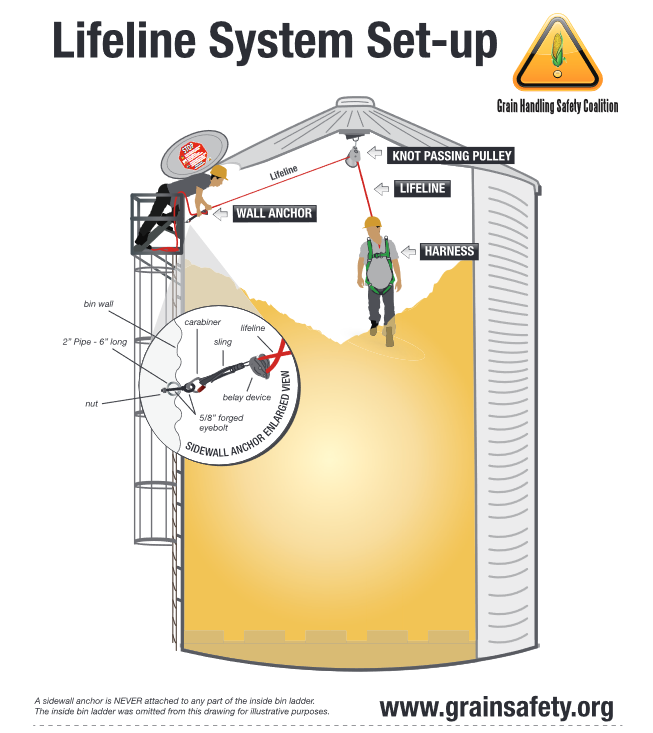 |
Figure 2. Full-body harness and lifeline on grain worker. (Photo: Grain Handling Safety Coalition) |
Entering Bins
Bin entry permits are required when entering a bin. If the plane between the inside of a bin and the outside environment is crossed, a permit is required. Bin entry permits are a safety checklist for the grain structure. Air monitoring, available safety equipment, grain levels and conditions and entrant and attendant names with signatures are all part of the bin entry permit. Every time a bin is entered, a new bin entry permit is required. Grain moves and conditions can change between entries, making it essential that bin entry permit steps be performed and documented.
While fumigation is never performed alone, bin entry should never be performed alone either. An attendant trained in rescue and emergency procedures must remain at The entry point and in contact with the person entering and working in The bin. That attendant never leaves this position until the entry is complete and the entrant is outside of the bin again.
Spoiled Grain Detection
Methods to detect grain spoilage and mold include temperature cables, CO2 sensors, visual inspection and detection of odors from the bin access points. The temperature will rise around areas in the grain that have biological activity from insects or mold. Each node on the temperature cable will sense about a meter around that node. CO2 sensors can detect biological activity when the fan starts. Any rise over the normal CO2 range (about 400-600 ppm) in the bin indicates that someplace in the bin there are insects or mold is forming. During visual inspection, look for a whitish dull appearance in the grain. Also look for clumping and grain stuck to walls or in mounds. Out of condition grain also emits an odor. Take care when looking into a bin in case the odors are dangerous. Smell only from outside the bin at the bin entrance. It is important to train employees on these methods of spoilage detection. They may be the first ones to detect a change in the grain during their regular work activities. The earlier problem is detected, the easier it is to remedy.
Sealing
It is critical to thoroughly seal the structure to be fumigated to contain the phosphine gas at the appropriate level for the designated time. Several products may be used to seal a structure: closed-foam sealant, duct tape, silicone sealant, heavy-weight (at least 6 mil) plastic and elastomeric sealer (Figure 3). Permanent areas that can be sealed include eaves and bases of structures, aeration fan motors and ducts, seams and missing hardware and areas around unloading equipment. Areas that will be sealed temporarily include bin door entries, roof ventilation, manhole covers, unloading sprouts and aeration fan intakes.
| Figure 3 | ||
|---|---|---|
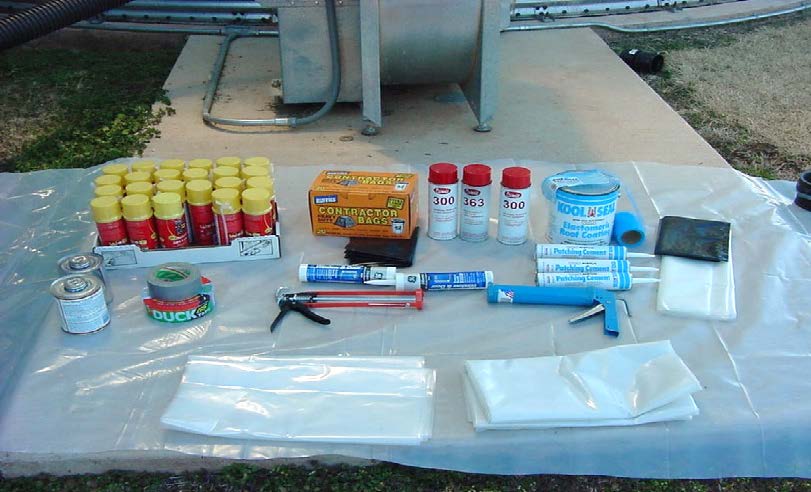 |
Figure 3. Products used for sealing grain structures. (Photo: Ron Noyes) |
Closed Loop Fumigation
Controlling where phosphine fumigant travels in the bin and evacuation of the gas is a challenge and concern for fumigators. Closed look systems take gas out of the headspace of the bin and return it to the bottom of the bin (Figure 4). For systems to be successful, extensive sealing is critical. A small fan removes the gas from the headspace and places the gas either directly into the bottom of the bin below the perforated flooring or into the aeration ductwork at the bottom of the bin. It is very important to seal the aeration fan and all vents to prevent the closed loop fan from forcing gas out of these areas. Closed loop systems have been shown to reduce the amount of fumigant required maintain effective gas concentrations by as much as 75% while providing better distribution of gas when compared to conventional methods of fumigation.
| Figure 4 | ||
|---|---|---|
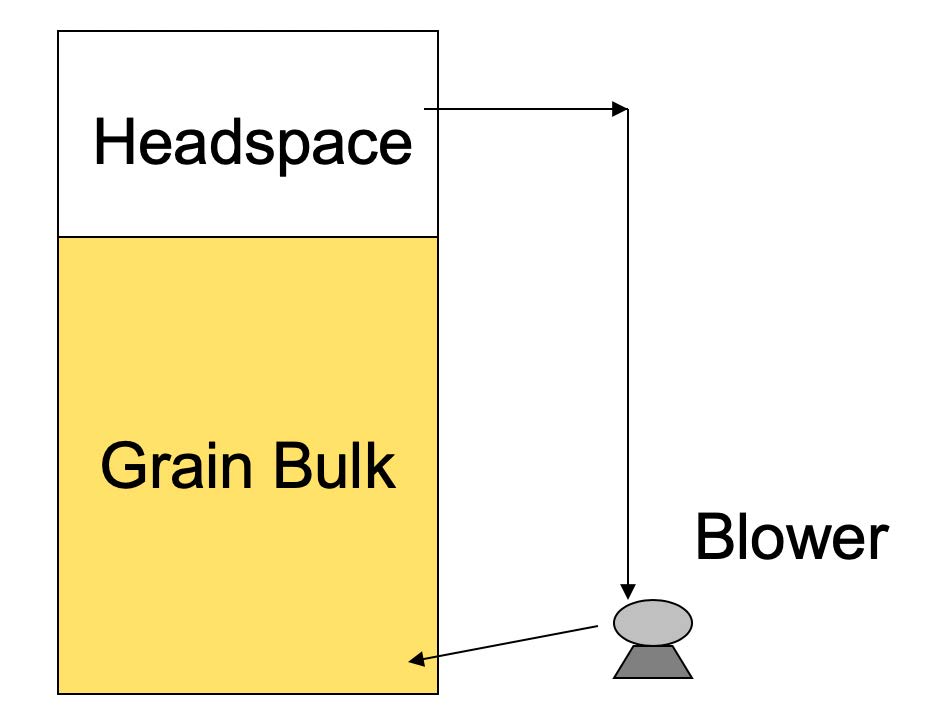 |
Figure 4. Closed loop system. |
Dosage
The maximum allowable dosage rate is 725 pellets per 1000 cubic feet which is equivalent to 900 pellets per 1000 bushels and 145 tablets per 1000 cubic feet which is equivalent to 180 tablets per 1000 bushels. The maximum allowable dosage rate for rodent burrows is 20 pellets per burrow or 4 tablets per burrow.
Protective Clothing
Protective clothing is necessary when using solid phosphine formulations. Wear dry gloves of cotton, preferably, or other material if contact with tablets, pellets or dust is likely (Figure 5). Gloves should remain dry during use. Always wash hands thoroughly after handling phosphine products. Aerate used gloves and other clothing that may be contaminated in a well-ventilated area prior to laundering.
| Figure 5 | ||
|---|---|---|
 |
Figure 5. Applying phophine pellets in a concrete silo. (Photo: Edmond Bonjour) |
Respiratory Protection
Respiratory protection is required when concentration levels of phosphine are unknown or when concentrations exceed permissible exposure limits of 0.3 ppm. A NIOSH/MSHA approved full-face gas mask phosphine canister combination (Figure 6) may be used at levels above 0.3 ppm up to 15 ppm. If the phosphine level is above 15 ppm or in situations where the phosphine concentration is unknown, a NIOSH/MSHA approved self-contained breathing apparatus (SCBA) must be worn (Figure 7). If phosphine is to be applied from within the structure to be fumigated, an approved full-face gas mask - phosphine canister combination or SCBA must be available at the site of application in case it is needed. Respiratory protection must also be available for applications from outside the area to be fumigated such as the addition of tablets or pellets to automatic dispensing devices, and outdoor applications.
| Figures 6 & 7 | ||
|---|---|---|
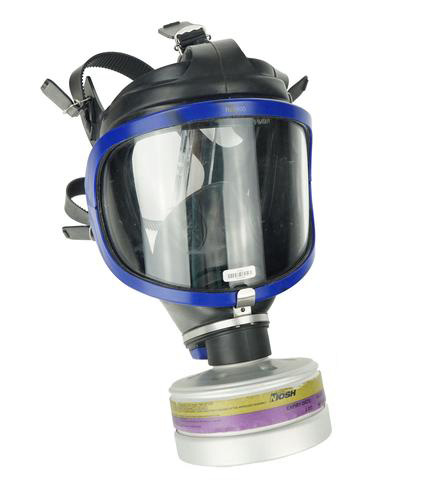 |
Figure 6. Full-face gas mask with phosphine canister. | |
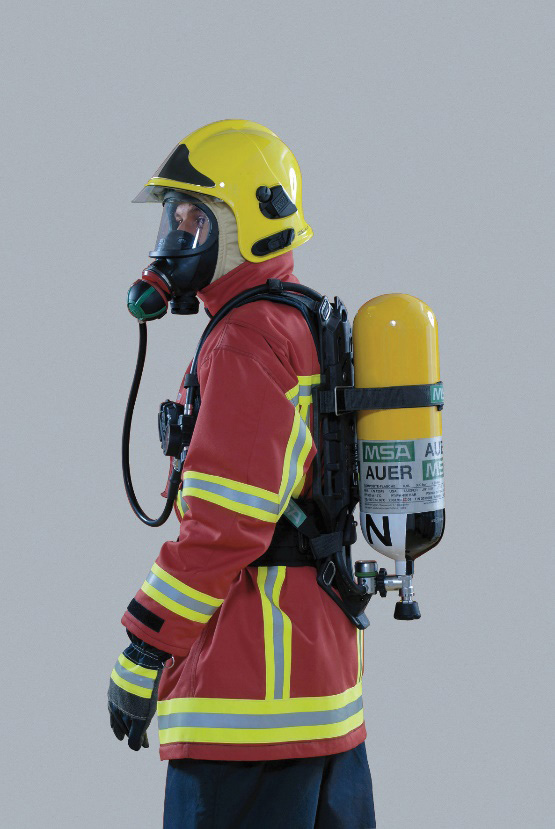 |
Figure 7. Self-contained breathing apparatus (SCBA). |
Certified Applicator
Whenever a fumigation is to be performed, a certified applicator must be physically present, responsible for, and maintain visual and/or voice contact with all fumigation workers during the opening of the product containers, during the application of the fumigant, and also during the initial opening of the fumigation structure for ventilation. During application of fumigant, at least two persons, a certified applicator and a trained person, or two trained persons under the direct supervision of the certified applicator must be present. Monitoring must be conducted in order to characterize the application and determine the fumigator's exposure. Document the phosphine reading levels and retain documents for two years. Before re-entry into a structure, the facility must be ventilated until the phosphine level is 0.3 ppm or below.
Persons with documented training in the handling of phosphine products must be responsible for receiving, ventilating and removal of placards from vehicles which have been fumigated in transit. The trained person must be trained by a certified applicator following the EPA accepted product applicator's manual that must precede or be attached to the outside of the transport vehicle. When training has been completed and the employee demonstrates safety safety knowledge proficiency, the training date must be recorded and maintained in the employee's safety training record for a minimum of three years. Refresher training must be done annually and documented.
Gas Detection Equipment
Structures storing grains may develop hazardous atmospheres because of gases given off by decaying grain or from a previous fumigation that was not ventilated properly after the fumigation was complete. Before entering any storage structure, it is important to determine that there is sufficient oxygen present and that the phosphine level is 0.3 ppm or lower. If a fumigant is detected or there is a lack of oxygen, the facility must be ventilated to ensure that the toxic gas levels are reduced to non-hazardous levels and that adequate oxygen levels are maintained.
Normal oxygen levels in the atmosphere range between 19-23%, but when they are lower than that range, workers can experience problems. Electronic oxygen sensors help prevent these dangers by accurately monitoring oxygen levels and triggering an alarm when the level drops below 19.5%, the current OSHA-mandated level (OSHA, 1996). Using an oxygen monitor helps determine that the working environment is safe to enter.
For phosphine gas detection, there are glass detection tubes or electronic monitors to determine the amount of phoshpine gas present. Glass detection tubes (Figure 8) with a sampling pump are portable, simple to use, only detect one gas, require little training to use, are relatively inexpensive, and are accurate. Glass tubes have an expiration date and must not be used if expired. Expired tubes may be retained and labeled "for training purposes only" to be used to determine the amount of phosphine present during a fumigation. Electronic gas detection monitors (Figure 9) are portable, may be complex to use and require extensive training, may be able to read multiple gases, are relatively rapid, are expensive, have a digital readout, must be calibrated, according to the manufacturer instructions and must be bump tested before each use or at a minimum, every 30 days.
Electronic gas detection monitors must be calibrated against a known standard. Calibration can be done in-house with the required gas and testing equipment (regulators and adaptors) or the monitor can be sent back to the distributor or manufacturer for calibration. The calibration gas must be introduced at the proper pressure and flow rate. Over-pressurization can damage the sensor. Monitors should be calibrated at the altitude at which they will be used as changes in atmospheric pressure will influence the instrument's response. For some instruments with an active sampling pump, the pump must be disconnected from the sensor and the gas glow rate set to match the sampling rate of the pump.
A bump test must be performed before every use of an electronic gas detection monitor. A bump test kit (Figure 10) verifies calibration by exposing the instrument to a known concentration of test gas. Instruments should be zeroed before the bump test is performed in order to give a more accurate picture of the bump test results. When performing a bump test, the test gas concentration should be high enough to trigger the instrument's alarm. If the bump test does not trigger the alarm, then a full calibration must be performed.
There has been some confusion regarding proper calibration procedures and frequency. To clarify the issue, the International Safety Equipment Association (ISEA) updated its position statement on instrument calibration in 2010 stating, "A bump test or full calibration check of direct-reading portable gas monitors should be conducted before each day's use in accordance with the manufacturer's instructions, using an appropriate test gas." If the instrument fails a bump test, it must be adjusted through a full calibration before it is used. The ISEA recommends more frequent testing if environmental conditions that could affect instrument performance are suspected, such as sensor poisons or excessively dusty conditions.
| Figures 8, 9 & 10 | ||
|---|---|---|
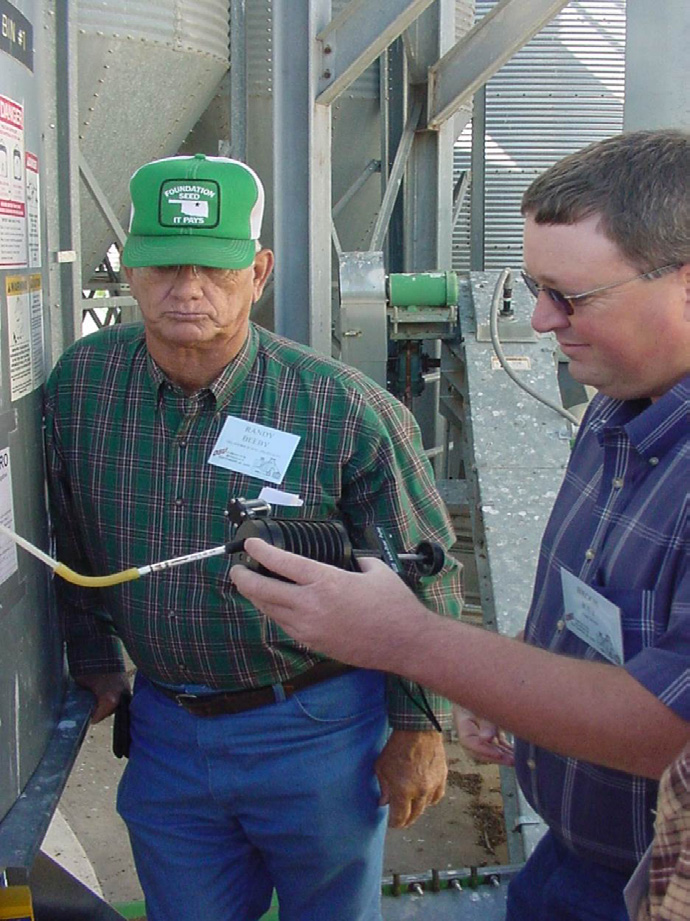 |
Figure 8. Using gas detection tubes to monitor phosphine levels. (Photo: Edmond Bonjour) | |
 |
Figure 9. Using an electronic gas detection monitor to determine the level of phosphine gas. (Photo: Edmond Bonjour) | |
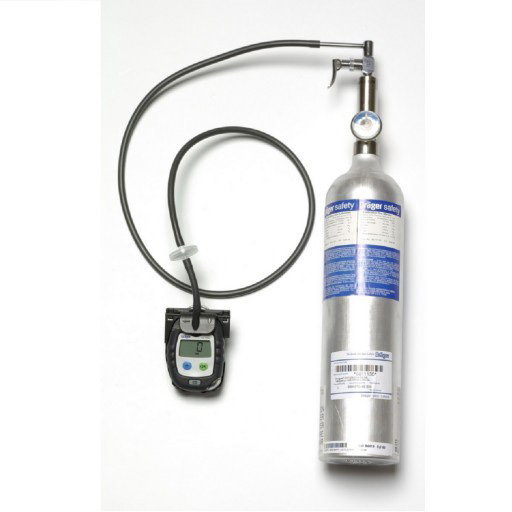 |
Figure 10. Bump test kit. |
Notification Requirements
Whenever a fumigation is to be performed, notification must be given to the local fire department and police department or sheriff. Provide them a copy of the SDS and complete label for the product to be used during the fumigation. After the fumigation is complete and proper ventilation has been conducted, notify the emergency departments that the fumigation has concluded. Immediately report theft of any phosphine product to the local police department of sheriff.
Placarding of Fumigated Areas
Placarding of structures and areas to be fumigated is essential to provide a safe environment for all personnel. All entrances to the fumigated area must be placarded. The placard (Figure 11) must be made of substantial material that can be expected to withstand adverse weather conditions and must bear the wording as follows:
- The signal words DANGER/PELIGRO and the SKULL AND CROSSBONES symbol in red
- The statement "Structure and/or commodity under fumigation, DO NOT ENTER/NO ENTRE"
- The statement, "The sign may only be removed by a certified applicator or a person with documented training after the structure and/or commodity is completely aerated (contains 0.3 ppm or less of phosphine gas). If incompletely aerated commodity is transferred to a new storage structure, the new structure must also be placarded if it contains more than 0.3 ppm. Worker exposure during this transfer must not exceed allowable limits."
- Date the fumigation begins
- Name and EPA registration number of fumigant
- Name, address and telephone number of the Fumigation Company and/or applicator
- A 24-hour emergency response telephone number
Where possible, placards should be placed in advance of the fumigation. For railroad hopper cars, placards must be placed on both sides of the car near the ladders and next to the top hatches into which the fumigant is introduced. Do not remove placards until the commodity or area is ventilated down to 0.3 ppm phosphine gas or less.
| Figure 11 | ||
|---|---|---|
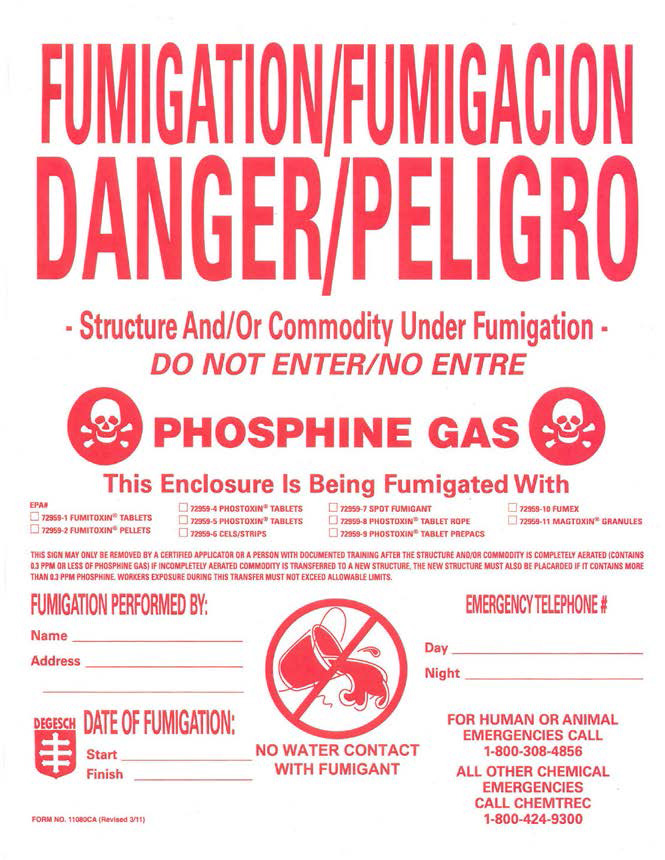 |
Figure 11. Phosphine placard. (Photo: Degesch America, Inc.) |
Storage
Do not contaminate water, food or feed by storing pesticides in the same areas used to store commodities. Store phosphine products in a dry, well-ventilated area away from heat, under lock and key. Make sure the door is posted as pesticide storage area. Do not store phosphine products in areas where temperature may exceed 130° F. Do not store phosphine in buildings where humans or domestic animals reside. As always, keep out of reach of children. For pellets and tablets supplied in gas-tight aluminum sealed flasks, once opened, the contents should be used completely. The shelf life of flasks containing phosphine products is virtually unlimited as long as the aluminum seal is not removed. At a minimum, the storage must be locked and marked with the following words and signs:
- Danger/Poison with skull and crossbones (Figure 12)
- Phosphine NFPA chemical label (Figure 13)
- Authorized Personnel Only
| Figures 12 & 13 | ||
|---|---|---|
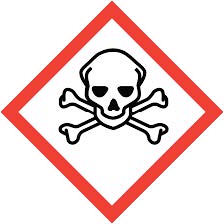 |
Figure 12. Skull and crossbones label. | |
 |
Figure 13. Phosphine NFPA chemical label. |
Transportation Instructions
The U.S. Department of Transportation (DOT) classifies aluminum and magnesium phosphide as Dangerous When Wet material and it must be transported in accordance with DOT regulations. There is a Special Permit, DOT SP-11329, that covers all the regulations for transporting phosphine.
Written Fumigation Management Plan
The certified applicator is responsible for working with the owners and/or responsible employees of the structure and/or area to be fumigated to develop and follow a Fumigation Management Plan (FMP). An FMP must be developed for each separate facility.
Other Structures that May be Fumigated
Barge fumigation is regulated by the U.S. Coast Guard. Small sealable enclosures may be fumigated but care must be taken not to overdose these fumigations. Beehives, supers and other bee keeping equipment may be fumigated but the honey from treated hives or supers may only be used for bee food, not for human consumption.
Burrowing Pest Control
An FMP must be written for all burrowing pest fumigations. The use of phosphine products is strictly prohibited within 100 feet of any building where humans and/or domestic animals do or may reside, on single or multi-family residential properties and nursing homes, schools (except athletic fields), daycare facilities and hospitals.
Disposal Instructions
Do not contaminate water, food or feed by storage or disposal of any phosphine product. Unreacted or partially reacted phosphine pellets or tablets are acutely hazardous. Improper disposal of excess pesticide is a violation of Federal Law. Triple rinse aluminum flasks and stoppers with water. Flasks may be recycled or reconditioned, or punctured and disposed of in a landfill or other procedures approved by state and local authorities.
Educating Stored Product Workers
Grain elevator and fumigation workshops are critical in helping keep stored product managers and workers educated and up to date on safety requirements and insecticides used in controlling insects in stored products along with their proper usage. Certified applicators and others working in this industry benefit from hearing regularly from university personnel and industry specialists working in the stored product area during these workshops. Our goal is to inform the stored product industry of safety regulations, new insecticides and good practices to utilize in this important agricultural endeavor.
References
D & D Holdings, Inc. 2018. Applicator's Manual for Phostoxin® Tablets and Pellets. Retrieved from www.degeschamerica.com.
Occupational Safety & Health Administration [OSHA]. 1996. Regulations (Grain Handling, OSHA 3103). Retrieved from https://www.osha.gov/Publications/3103.html.
